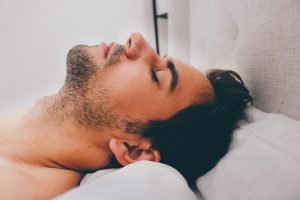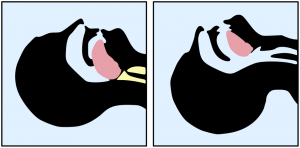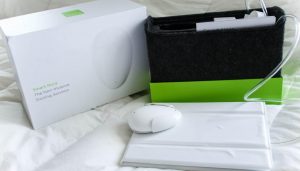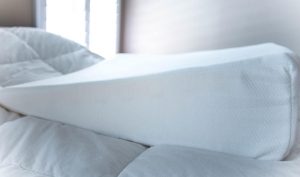I’ve spent the last few years testing the selection of anti-snoring pillows available on the market. After many trials, I have made several conclusions based on my personal experience and want to share some of my test results.
It is important to me to have a comfortable and effective anti-snoring pillow when I sleep at night. Using the right pillow for your level of snoring should be one of your first considerations when you begin your quest to reduce your snoring. A good anti-snoring pillow will complement a snoring mouthpiece such as SnoreRx or Zyppah.
One of the main culprits of snoring is relaxed throat muscles when you are sleeping. The position of your head can affect and worsen the level of your snoring.
I tested multiple pillows that claim to adjust your head position throughout the night to help alleviate snoring: the Nitetronic goodnite Anti-Snoring Pillow, the LevelSleep Restore pillow, the Sharper Image Pillow and the Smart Nora Pillow.
The LevelSleep Restore is an anti-snore, anti-wrinkle pillow modeled on designs that saw reductions in snoring of 78%. Features of the LevelSleep include customizable lumbar support, natural spinal alignment, and improved airflow.
The Restore is the only pillow available with ear wells for side sleeping. The 110 Day Free-Trial makes this pillow a great option. In addition to trying these pillows for 110 days, you can get 10% off your purchase by using our exclusive discount coupon code during checkout: SNORINGHQ
The Sharper Image Pillow is a memory foam pillow contoured in a manner meant to align your jaw and open your airways, thus increasing the airflow and making it easier to breathe. The pillow cradles your head and makes sleeping on your side incredibly comfortable. The pillow tilts your head back at a gentle angle, which isn’t particularly noticeable.
The Nitetronic goodnite Anti-Snoring Pillow monitors your breathing sounds and head position on the pillow. The pillow’s air chambers and head position sensors detect snoring and will gently turn your head to the side to stimulate the relaxed throat muscles that cause the vibrations.
The pillow movements are gentle and don’t wake you or your partner up at night, so no more elbows in the ribs and being told to turn on my side! The pillow continues to inflate and deflate throughout the night based on your snoring patterns.
This is truly a smart pillow because it works with two apps connected by Bluetooth to generate sleep data that can help you track your snoring over time.
Unlike the Nitetronic, LevelSleep Restore(TM) and Sharper Image pillows, the Smart Nora Pillow uses the Air Tube, which is a pillow insert that works in conjunction with your own pillow. If positioned correctly under your head, the pillow will inflate and deflate through the night to change your head position.
The Smart Nora detects snoring sounds through a wireless device called the Pebble. The Pebble can be mounted on your headboard, wall, or sit on your nightstand, and requires frequent charging which I found frustrating.
The Nitetronic goodnite™ Anti-Snoring pillow outperformed the other pillows in my trials. It was the most successful at detecting and reducing my snoring, which was the objective.
It was not as comfortable as the LevelSleep Restore(TM) pillow, the Sharper Image pillow or the Smart Nora device, but the ease of use and value coupled with a more restful night made it the clear winner for me. Plus, it offers a full money back guarantee. I was happy to give it an almost 5-star review.
The LevelSleep Restore(TM) pillow and Sharper Image pillow was effective at reducing my snoring and very easy to use. With no technology attached to it, set up only involved putting the pillow on my bed. The contours of the pillow were comfortable and I could sleep on my side at night.
However, if you are a restless sleeper and toss and turn at night, these pillows may not be for you. The Sharper Image pillow was definitely more comfortable than the Nitetronic pillow and would be ideal for those who experience slight to moderate snoring.
Coming in fourth place, the Smart Nora pillow was still an effective pillow at snoring detection and reduction. Of the anti-snoring pillows, it was the most comfortable. This is likely because I could use my own pillow with the air pad insert which I loved.
But, it was not nearly as easy to use as the Nitetronic or Sharper Image pillow and that is where it lost points with me. Remembering to charge the Pebble became a chore and I found the pillow insert did not inflate properly if it was not placed exactly right under my pillow.
Your pillow is one of your most valuable tools in reducing your snoring. Everyone has their own personal preference when it comes to pillows, and by using the Snoring HQ discounts, you can give each of these pillows a trial with little or no risk. Use these reviews to test out the pillows and see which one works best for you.
The Science Behind Snoring Pillows

How Sleeping Positions Affect Snoring
Contrary to popular belief, snoring doesn’t originate from your nose. Rather, it’s a byproduct of tissues in the throat relaxing and obstructing air pathways during sleep.
The unpleasant snoring noise is the sound of those tissue vibrating as you breathe. Studies have shown that sleeping positions directly correlate to snoring intensity.
The orientation of your head and neck affects the way your soft palette moves when it relaxes during as you sleep. Depending on your sleeping position, this can either increase or decrease your snoring problem.
Back Sleepers are the Worst Snorers
Individuals who sleep on their back generally snore more intensely than people who do not. When you sleep on your back, your chin tends to fall toward your chest as your body relaxes. This restricts ventilation through your air pathways and intensifies snoring. Furthermore, when you sleep on your back, your jaw relaxes and your tongue recedes to the back of your mouth, often blocking the airway. The reason that people who snore intensely are usually back sleepers is because when their jaw relaxes and moves backward, their mouths also fall open. This combination of a tucked chin, a receded tongue, and an open mouth amplifies vibrations in the throat and increases snoring to unbearable levels.
How Sleeping on Your Stomach Affects Snoring
Stomach sleepers have a lower snoring risk because when your lie on your stomach, the side alignment of your head and neck reduces the occurrence of airway obstructions. Sleeping on your stomach is sometimes an effective way to stop snoring.
However, this position places a lot of pressure on your shoulders and lower back, and you’ll eventually need to sleep with some form of stomach or pelvic support to lessen the stress those areas incur at night.
Sleeping on Your Side Reduces Snoring
Sleeping on your side is the simplest way to decrease your risk of snoring. When you lie on your side, you minimize pressure on your throat and neck, which lower your chances of blocking your air pathways.
Very mild snorers, as well as people who don’t suffer from chronic snoring, can sometimes cure their problem by sleeping in this position. Sleeping on your side also keeps your jaw from moving and prevents your tongue from collapsing to the back of your mouth.
In this position, your head and neck stay elevated without restricting your airways. But, if you tend to curl up in your sleep while on your side, it’s unlikely this position will stop your snoring.
What You Need from a Snoring Pillow
Changing your sleeping habits can positively affect your snoring, but it doesn’t work for everyone, and some positions can negatively affect your body. For example, lying on your back is the best posture to assume during sleep.
Sleeping on your back elongates the spine and reduces lower back and neck pain. However, lying in this position significantly increases the intensity of your snores. Back sleepers benefit from anti-snore pillows that cradle the back of the head and prevent it from falling forward.
In addition to reducing snoring, sleeping on your side can also eliminate nocturnal acid reflux symptoms like heartburn. On the other hand, side sleeping can also put a lot of pressure on the base of the neck and trapezius muscles (neck, upper, and mid-back), leaving you feeling sore when you wake up.
If you sleep on your side, you’ll probably want a firm pillow that supports your shoulders and the curvature of your neck. Anti-snore pillows generally don’t work for stomach sleepers because they’re designed to support side or forward sleeping positions. If you normally sleep on your stomach, you’ll need a thin or flat pillow that maintains your head and neck alignment.
Fuller pillows will elevate your head too much, place pressure on your neck muscles and airways, and ultimately, increase your risk of snoring. For stomach sleepers, it’s important to keep your head and neck neutral but aligned with your torso.
How Snoring Pillows Adjust the Head
Most anti-snore products, namely Mandibular Advancement Devices or MADs, address the snoring problem by limiting your mouth and jaw movements. These devices (one of the most popular is SnoreRx) prevent the jaw from sliding backward while your sleep and keeps your airways open.
Other anti-snoring products like TRDs (tongue restraining devices) eliminate snoring by holding your tongue in place. Unfortunately, these products don’t work for everyone. People who wear braces or certain types of retainers might be unable to use MADs or TRDs.
Furthermore, while they can be comfortable, getting used to wearing these devices at night can take anywhere from a couple days to several weeks.

Anti-snore pillows operate under a similar concept as most other anti-snoring devices: they affect jaw and mouth position to minimize airway obstructions. Rather than deal with snoring by forcing your jaw to stay in place, these devices focus on correcting the natural alignment of your head and neck.
When lying on your back, snoring pillows tilt your head backward so that the muscles in your neck activate slightly and lifts your chin toward the ceiling. Emergency responders use a similar head tilting method to ensure that unconscious patients can breathe properly.
Maneuvering the head in this manner is the most reliable way to keep air pathways open. When you lie on your side, the snoring pillows support your shoulder and reduce airway obstructions by aligning your head and torso.
Types of Anti-Snore Pillows
There are several types of snoring pillows, and the features they offer vary widely from one product to another. The primary types are wedge, contour, u-shape, foam, full-body, inflation, and CPAP pillows.
Inflating Pillows (Smart Anti-Snoring Pillows)
Inflating pillows are the most interesting type of snoring pillow because they combine sonic sensor technology and self-inflation. The science behind the design of these “smart” inflating pillows is simple: the pillow automatically changes your head position throughout the night when it detects snoring.

By inducing head movement, inflating snoring pillows stimulate your relaxed throat muscles, causing them to contract, which temporarily stops snoring. Depending on the product, the snoring sensors can be external or built into the pillow.
The air chambers of some inflating pillows only raise or lower your head when the sensors pick up snoring noises. Other smart snoring pillows gently move your head horizontally depending on the intensity of your snores.
Most snorers don’t need a lot of prompting to change positions, so the subtle movements of these snoring pillows won’t wake you up. The size and shape of inflating pillows also vary by company and manufacturer. Many smart snoring pillows look like standard pillows and offer no additional head or neck support.
However, there are also inflating snoring pillows made from contouring materials like memory or latex foam available on the market. Regardless of the type, inflating pillows are known to be very effective against snoring and most users are pleased with their results.
U-Shape Pillows
U-shaped pillows resemble travel neck pillows but serve a different purpose. These pillows reduce snoring by supporting the head and neck in the side sleeping position. The curved part of the pillow wraps around your head, lifting its weight off your shoulders and neck. The long ends extend outward and wrap around your body.
These pillows are perfect for people who don’t usually sleep on their side because they support your weight in a way that won’t strain your neck or leave you sore in the morning. Some varieties even have cutouts for your ears to reduce the weight placed on them when you sleep.
Similarly designed, L-shaped pillows are also gaining in popularity among snorers. L-shaped pillows use the same concept as U-shaped ones, but they tend to be wider, softer, and less portable. The sharp bend of L-shaped snoring pillows lets them neatly fill the gap between your neck and shoulder.
If you sleep with this pillow wrapped around your arm, its soft, sturdy padding will cushion your weight so that you don’t cut off your circulation and wake up with that awful pins and needles feeling. Unlike U-shaped pillows, the design of L-shaped anti-snore pillows makes them perfect for sleeping in any position.
They’re especially useful for stomach sleeping snorers because they are thinner than other shaped pillows and promote neck alignment through torso support.
Contour Pillows
As the name suggests, contour pillows contour to your head to provide you with the best night’s sleep. These pillows are the products of rigorous medical research and widely popular in the sleep and anti-snoring industry. Though not medical cures for snoring, these generic contour pillows usually help mild to moderate snorers and those with certain types of sleep apnea.
Anti-snore contour pillows have a wave design that supports the back of your neck while holding your head in place. This prevents your head from falling toward your chest as you sleep and blocking your airways. Contour pillows are usually made from high-quality memory foam that conforms to your shape while you sleep and returns to its original shape when you’re no longer resting on it.
Contour pillows also help relieve neck and shoulder pain because they support your body’s natural posture. Side sleepers can also benefit from using contour pillows. The raised, rounded areas of the pillow fit into the curve of your shoulder and neck. The indentation in the middle cradles your head so it remains stationary throughout the night and your air pathways stay clear and open.
Foam Pillows
There are two types of foam pillows: memory foam and latex foam. Memory foam is soft, malleable, and very comfortable to sleep on. You typically see this material in contour and wedge pillows because it gives additional support that reduces snoring. Memory foam molds to whatever shape presses on it, so it’s not a good idea to use them when sleeping on your stomach.
Sleeping on your stomach with memory foam pillows may disrupt the alignment between your head, neck, and shoulders. If you must sleep on your stomach, latex foam snoring pillows are a better choice. Latex foam snoring pillows are typically firmer and flatter than their memory foam counterparts.
Although these pillows are sturdier than memory foam, they still contour to the head and neck. Back and side sleepers benefit from using latex foam snoring pillows that are slightly curved at the center. Pillows with this shape keep your airways open and aligned while reducing head movements that can exasperate snoring.
Wedge Pillows

Named for their triangular shape, these incline anti-snore pillows elevate the head a few inches off the bed. Wedge pillows are popular among snorers because their shape allows them to effectively combat snoring symptoms.
They help keep your air pathways open by aligning your head, neck, and spine. Beyond their basic triangular shape, wedge pillows vary greatly depending on the company that manufactures them.
You can find wedge pillows with steep inclines or ones that are similar in size and elevation to regular pillows at online retail stores. Wedge pillows are an industry favorite because they address the undesirable symptoms of several health issues.
Those who suffer from Gastroesophageal Reflux Disease (GERD) will find the gentle incline of wedge pillows helps lower acid production. Moreover, wedge pillows come in a variety of materials. You can buy them in memory foam, latex foam, or as inflatable pillows.
Full-Body Pillows
Full-length body pillows provide support for your neck and shoulders as well as your back and pelvic area. C and J-shaped snoring pillows (as well as U and L-shaped pillows if they’re large enough) are two examples of pillows in this category.
Like other anti-snoring pillows, full-length body pillows decrease snoring by realigning your sleeping posture and propping your head to open air pathways. J-shaped snoring pillows have a curve at one end to fill the gap between your neck and shoulder.
These pillows give the user more room on one side than U or C-shaped pillows, so they’re ideal for snorers who need more neck support, but don’t like to feel constricted. C-shaped snoring pillows curve at both ends, providing support to the head, shoulders, and pelvis.
These pillows work best for side sleepers but do very little to alleviate snoring if you use them for back or stomach sleeping positions.
On a side note, C and U-shaped body pillows are also the recommended type for pregnant mothers because they can promote proper sleeping posture and help alleviate lower back pain. Therefore, if you are pregnant, a snorer, and experience back pain, consider buying a full body snoring pillow.
CPAP Pillows
CPAP pillows address the specific sleeping posture needs of people who use CPAP machines while they sleep. CPAP (continuous positive airway pressure) machines use a pump to send air into the nasal cavity. The pressure from the pump forces your airway to stay open. CPAP is a device commonly used to treat obstructive sleep apnea (OSA).
Patients who suffer from OSA experience abnormal pauses in their breathing due to a physical blockage in their airways. Like regular or “simple” snoring, OSA occurs when the muscles of your throat relax during sleep and constrict air pathways.
Unlike normal snoring symptoms, with this type of apnea, the airway becomes completely blocked which causes the patient’s breathing to stop and start repeatedly during the night. Although obstructive sleep apnea is common, it can be fatal if blocked airways don’t re-open while you’re asleep.
To combat these symptoms, patients who suffer from OSA often wear a facemask that’s connected to a CPAP machine.
Frequently Asked Questions
How Effective Are Snoring Pillows?
Ultimately, the effectiveness of a snoring pillow will depend on your sleeping position and level of snoring. For example, heavy snorers and back sleepers usually find inflating pillows and wedge pillows help their symptoms the most.
Contour snoring pillows work best for mild to moderate snorers. Side sleepers can use almost any anti-snoring pillow, but shaped pillows might not work for heavy snoring side sleepers.
Who Can Use Snoring Pillows?
Almost everyone can use anti-snore pillows, but they might not work for people who suffer from sleep apnea. Although many anti-snore pillows help reduce the symptoms of OSA, unless otherwise stated on the product, most snoring pillows aren’t very effective against most types of sleep apnea.
If you’ve been diagnosed with a form of sleep apnea, you should consult your doctor about formal treatment and about which products would best help your situation.
What Should I Do If Anti-Snore Pillows Don’t Work for Me?
If you aren’t getting the results you want, don’t give up. The market for anti-snoring products is extensive, and new, innovative anti-snoring technology is introduced frequently.
Check out my comparison page for anti-snoring devices for more ideas of the types of snoring devices available on the market. You can also access my in-depth reviews about each product from the comparison page.
Final Thoughts
Anti-snore pillows are an effective solution to the snoring problem that plagues numerous households. They provide head, neck, and shoulder support, and adjust your sleeping posture so that your airways stay open when your throat muscles relax while you’re asleep.
As with other anti-snore products, using snoring pillows may take a while to get used to, and there’s no guarantee you’ll see any changes in your snoring habits. Nevertheless, this doesn’t mean you should stop trying anti-snore products altogether.
Presently, the market caters to side and back sleepers, but an increasing number of designers and engineers are making anti-snore pillows anyone can use regardless of their preferred sleeping position. Not everyone finds the anti-snoring product that meets all their needs on the first try.
Regardless of an anti-snore device or pillow’s reviews, every person is different, and everyone has their own personal preference when it comes to pillows. Therefore, your experience with snoring pillows will be different from mine.
The most important thing to remember when looking for an anti-snore pillow is to never sacrifice your comfort. Because anti-snore pillows adjust and support your sleeping posture, forcing yourself to use a different or uncomfortable sleeping position can cause muscle strain.
If you want to try different pillows before settling on a single product, you can give each of these pillows a try with little to no risk if you use the SnoringHQ discounts. Don’t forget to check out the individual snoring pillow reviews for more insight on their comfort and effectiveness. Use these reviews to test out the pillows and see which one works best for you. With a little patience, determination, and the right preparation, you can turn your pillow into your most valuable means of stopping your snoring habit.

